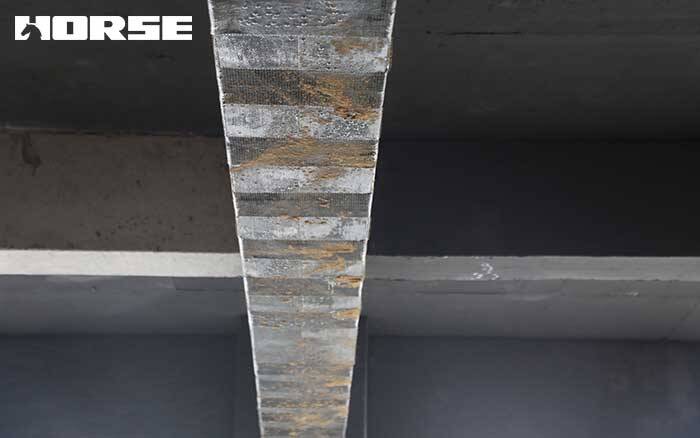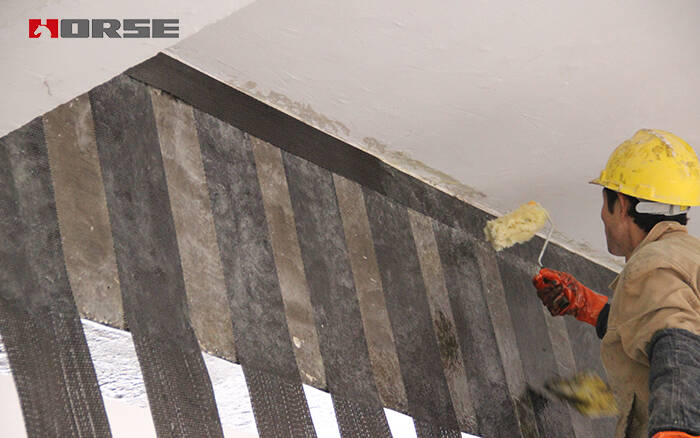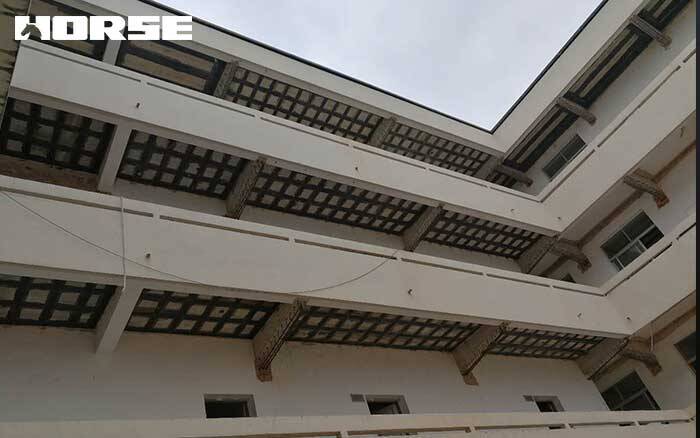Solutions
Horse Construction offers full range of structural strengthening materials with technical supports, documentation supports, products supports, project supports.
Compared with traditional reinforcement methods, what are the advantages of carbon fiber reinforcement

Before the advent of carbon fiber reinforcement technology, the traditional reinforcement technology in construction engineering was also a dazzling array, but eventually failed due to its operating conditions, appearance after reinforcement, and reinforcement effects that were not matched by carbon fiber reinforcement. Next, we will introduce and compare these two methods as follows.
1. Compared with traditional reinforcement materials, the advantages of carbon fiber materials
(1) Tensile strength: The tensile strength of carbon fiber is 7-10 times that of steel with the same cross-section.
(2) Elastic modulus: The tensile elastic modulus of carbon fiber composites is higher than that of steel, but the tensile elastic modulus of aramid and glass fiber composites is only half and one-fourth of that of steel.
(3) Fatigue strength: The fatigue strength of carbon fiber and aramid fiber composites is higher than that of high-strength wire. Under the action of alternating stress, the fatigue limit of metal materials is only 30% to 40% of the static load strength. Because the fiber and matrix composite can alleviate crack propagation and the possibility of fiber internal force redistribution, the fatigue limit of composite materials is relatively high, about 70% to 80% of the static load strength, and there are significant signs of deformation before failure.
(4) Weight: The density is only 1/4 of ordinary steel, and its weight is about one-fifth of steel.
(5) Comparison with carbon fiber board: carbon fiber sheet can be pasted on the structure surface of various shapes, and the board is more suitable for the surface of regular components. In addition, since the amount and thickness of the bottom layer resin are more than that of the sheet when pasting the board, the bonding strength of the interface with the concrete is not as good as that of the sheet.
(6) Good durability, can resist the damage of chemical corrosion, harsh environment and climate change.
2. Carbon fiber reinforcement technology and effect characteristics
(1) The construction is simple and fast. The use of carbon fiber reinforced components does not require large construction institutions and turnover materials, is easy to operate, has a short construction period and is economical.
(2) Anti-corrosion of acid, alkali and salt media, with a wide range of applications. After reinforcement, the corrosion resistance and durability of the structure can be greatly improved, and it can be applied to the reinforcement of components in various working environments.
(3) It can effectively close the cracks of the concrete structure and prolong the service life of the structure.
(4) It is easy to maintain the original structure of the structure, and basically does not increase the weight of the structure and the cross-sectional size.

3. Advantages of tools used for carbon fiber reinforcement
Carbon fiber reinforcement technology is much simpler than traditional reinforcement methods in specific construction operations, which can be seen only from the construction tools.
(1) Substrate processing tools:
①Grinding machine: used for polishing the surface of concrete
②Chisel: used to pick up the concrete residue on the loose part of the concrete surface
③Wire brush: used to remove dirty stains on the concrete surface
(2) Paste carbon fiber:
① Seasoning container: used to blend epoxy resin
②Weighing apparatus: used to weigh the weight of each component of the material
③Agitator: used for mixing resin materials
④Scraper: used for repairing unevenness and pasting carbon fiber for smoothing
⑤ Roller brush: used for painting resin
⑥Roller: used for deaeration and compaction of carbon fiber
(3) Testing tools:
① Leaning ruler: used to check the flatness of the concrete surface
② Feeler gauge: used in conjunction with the ruler
③Hygrometer: used to measure atmospheric temperature and humidity
④Snare drum hammer: used to check hollow drum
⑤Tape measure and steel ruler
(4) Repair tools
①Glue injector: used to inject bonding resin into the hollow drum
②Cutting knife: used to cut the carbon fiber sheet at the hollow drum in order to inject the bonding resin

4. Benefits of carbon fiber reinforcement
Carbon fiber reinforcement, as long as the design is reasonable, is about the same as the general sticking steel plate method. However, the carbon fiber reinforcement method is convenient for construction, high work efficiency, no wet work, no on-site fixed facilities, less space for construction, and obvious advantages in terms of construction period and construction conditions. The carbon fiber reinforcement method has good reinforcement effect, high strength and high efficiency, wide application range, easy quality assurance, excellent corrosion resistance and durability. After the use of carbon fiber reinforcement and repair, the weight of the original structure and the size of the original components are basically not increased.
Carbon fiber reinforcement has many advantages such as light weight, high strength, corrosion resistance, aging resistance, good durability, and stable physical properties. Its tensile strength is 7-10 times that of steel with the same cross-section. The use of carbon fiber reinforced materials to repair and strengthen concrete structures is a new type of construction method developed recently. It works together with the concrete structure and uses the excellent tensile strength of carbon fiber materials to achieve the purpose of enhancing the load-bearing capacity and rigidity of the members. This technology has many advantages such as simple and quick construction, safe and reliable, good durability, can adapt to various complex structural shapes, and does not affect the appearance of the original structure. It has been widely used in seismic repair and reinforcement of concrete structures.
Compared with the traditional reinforced concrete cross-section or steel-bonded concrete reinforcement, carbon fiber has the advantages of space saving, simple construction, no need for on-site fixing facilities, easy construction quality, and basically no increase in structural size and self-weight. Therefore, as an epoch-making reinforcing material, carbon fiber has attracted much attention and attention. The use of carbon fiber cloth to strengthen the structure has the advantages of high strength and high efficiency. Due to the excellent physical and mechanical properties of carbon fiber materials, in strengthening and repairing concrete structures, the bearing capacity and ductility of concrete structures and components can be improved, and their stress performance can be improved to achieve the purpose of efficient reinforcement and repair. The construction is convenient, the work efficiency is high, the wet operation is not required, and the construction takes up less space.
It has a wide range of applications, and it can be widely used in various types of structures (such as buildings, structures, bridges, tunnels, etc.) to reinforce and repair concrete structures with carbon fiber materials. Can be widely applied to various structural shapes (such as rectangular, circular, curved structure, etc.). It can be widely used in the reinforcement and repair of various structural parts (such as beams, slabs, columns, nodes, arches, shells, piers, etc.). And does not change the shape of the structure, which is unmatched by any current structural reinforcement method.
Particularly important is the smooth construction of some large bridge piers, bridges, bridge slabs, tunnels, large cylinders and shell structures. It is almost impossible to implement the old reinforcement method, but the reinforcement technology can be used to solve the problem smoothly, and the construction quality is easy to guarantee.
Because the carbon fiber material is flexible, even if the surface of the reinforced structure is not very flat, it can basically achieve an effective adhesion rate of 100%. However, it is difficult to achieve 100% of the effective adhesive surface for the pasted steel plate, and the corresponding acceptance standard only requires it to reach 70%.
The carbon fiber material is light and thin. The weight per square meter after pasting is less than 1.0kg, and the thickness of the pasted layer is only about 1.0mm. After reinforcement and repair, the weight of the original structure and the size of the original components are basically not increased.
You can find anything here you are in need of, have a trust trying on these products, you will find the big difference after that.

High strength, unidirectional carbon fiber wrap pre-saturated to form a carbon fiber reinforced polymer (CFRP) wrap used to strengthen structural concrete elements.

High strength, unidirectional carbon fiber fabric pre-saturated to form a carbon fiber reinforced polymer (CFRP) fabric used to strengthen structural concrete elements.

High strength, unidirectional carbon fiber sheet pre-saturated to form a carbon fiber reinforced polymer (CFRP) sheet used to strengthen structural concrete elements.